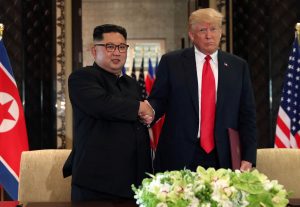
By John Geddie
SINGAPORE (Reuters) – U.S. Vice President Mike Pence said on Thursday President Donald Trump plans to meet North Korean leader Kim Jong Un in 2019 and will push for a concrete plan outlining Pyongyang’s moves to end its arms programs.
The United States and North Korea have been discussing a second meeting of their leaders after a June summit in Singapore to lay the groundwork for ending a nuclear standoff between the old foes.
“The plans are ongoing. We believe that the summit will likely occur after the first of the year, but the when and the where of that is still being worked out,” Pence told reporters after meeting South Korean President Moon Jae-in.
In a separate interview with NBC News, Pence said the United States would not require Pyongyang to provide a complete list of nuclear weapons and locations before the second summit but that the meeting must produce a concrete plan.
“I think it will be absolutely imperative in this next summit that we come away with a plan for identifying all of the weapons in question, identifying all the development sites, allowing for inspections of the sites and the plan for dismantling nuclear weapons,” Pence said.
Pence and Moon were meeting on the sidelines of an Asia-Pacific summit hosted by Singapore.
A U.S. think tank said on Monday it had identified at least 13 of an estimated 20 active, undeclared missile bases inside North Korea, underscoring the challenge for American negotiators hoping to persuade Kim to give up his weapons programs.
North Korea had entered into agreements with regional powers in 1994 and in 2005 to dismantle its nuclear program in return for economic benefits and diplomatic rewards, but those deals broke down after Pyongyang clandestinely continued to pursue building weapons of mass destruction.
With scant sign of progress on negotiations since the June summit and recent high-level meetings canceled, Trump said last week he was now in “no rush” but still wanted to meet with Kim for a second time.
“We’re going to keep the pressure on. We’re going to keep the sanctions in place,” Pence told NBC. “President Trump continues to be very hopeful that in that next summit, we’ll come out with a plan for actually implementing and achieving denuclearization.”

FILE PHOTO: U.S. President Donald Trump shakes hands with North Korea’s leader Kim Jong Un after they signed documents that acknowledged the progress of the talks and pledge to keep momentum going, after their summit at the Capella Hotel on Sentosa island in Singapore June 12, 2018. REUTERS/Jonathan Ernst/File Photo
U.S. officials have said sanctions forced North Korea to the negotiating table and vowed to keep pressure until complete denuclearization. But North Korea has credited its nuclear and missile breakthroughs for providing it the standing to meet the world’s biggest powers.
Pence told reporters that Moon agreed to work closely with the United States toward the second U.S.-North Korea summit, as Washington maintains the “maximum pressure” campaign by keeping the sanctions against Pyongyang in place.
Asked if China, which has been the North’s main economic benefactor, was doing enough to maintain sanctions pressure, Pence said Beijing has done more than they have ever done before and Trump was grateful for that.
A U.S. congressional commission said on Wednesday China appeared to have relaxed enforcement of sanctions on North Korea as Pyongyang began to engage with the United States this year.
Trump is expected to speak more about enforcing sanctions when he meets Chinese President Xi Jinping at the G20 summit late this month and the unique role that China can play in ensuring the denuclearisation of the Korean peninsula, Pence said.
North Korea has not tested a nuclear device or ballistic missile since last year, and has said it has shuttered its main nuclear test site, with plans to dismantle several more facilities.
But it has warned it could restart its nuclear program if the United States does not drop the sanctions regime.
(Reporting by John Geddie in Singapore; Additional reporting by Susan Heavey in Washington; Writing by Jack Kim; Editing by Paul Tait, Raju Gopalakrishnan and Bernadette Baum)


